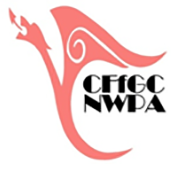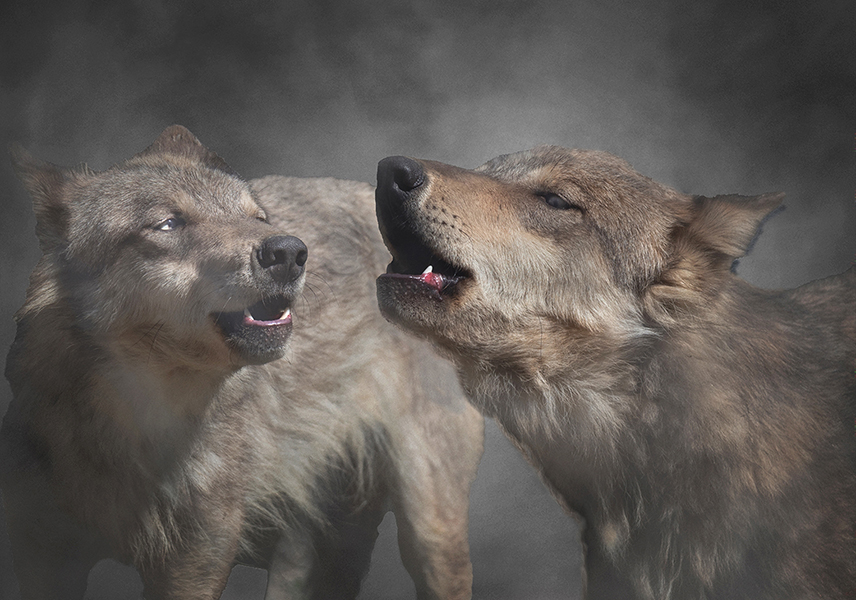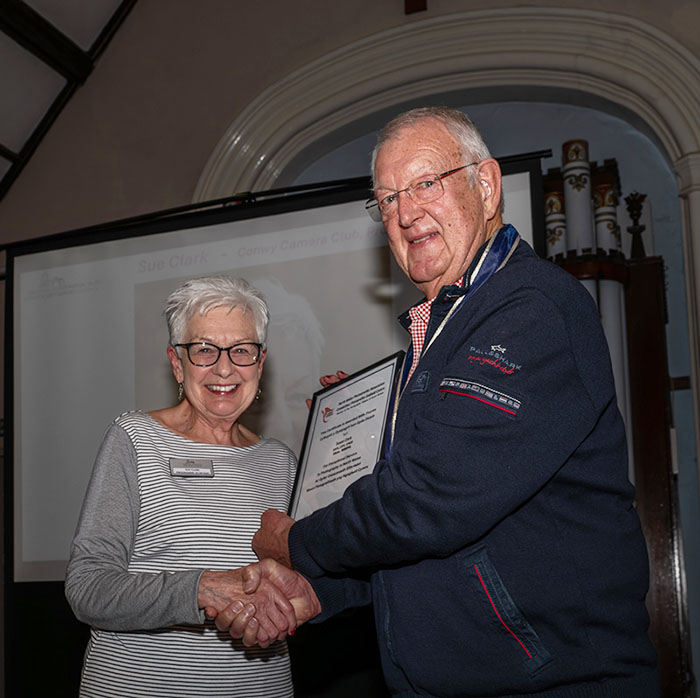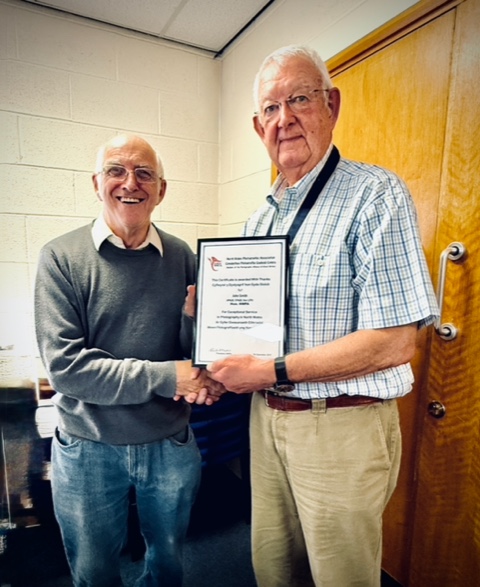
North Wales Photographic Association
Cymdeithas Ffotograffig Gogledd Cymru
Member of the Photographic Alliance of Great Britain
- Home
- About us
- Documents
- Calendar
- Competitions
- Exhibitions & Salons
- NWPA Handbook
- Events
- External Links

Latest News
Dont miss any of our Newsletters - Subscribe NOW
NWPA PDI Challenge 2025
An overview of the day can be downloaded here
All the Club Scores can be viewed HERE
All the Subject Scores can be viewed HERE
Aneurin Phillips - Kenya 2025 - Click here to download his adventure in hs own words and photos.
Sue Clark HonNWPA
Congratulations to Sue Clark on receiving and HonNWPA award for exceptional services , Here's Sue receiving her award from president Charles Meadows at Conwy camera Club
Nomination for Susan Clark for NWPA Hons:
Sue has made a rich and varied contribution to amateur photography in North Wales since she joined Conwy Camera Club in 2010. She is always in great demand as a speaker and a judge across North Wales and further afield. She is a highly competent photographer and has a passion for the history of photography and photographic techniques having embraced Photoshop since its infancy.
Despite being one of the largest clubs in North Wales over the last 20 years, Conwy has produced relatively few competition judges. Sue is a very well respected judge throughout North Wales and beyond and is known to be scrupulously fair, always well prepared and highly professional. Feedback from clubs where she has judged is always positive! The Club is grateful to Sue for her tireless work as a judge and proud of her experience and expertise and is proud of the high esteem in which she is held.

John Smith HonNWPA
Well done and congratulations to John Smith Hon NWPA! here's the man himself receiving an Honourable NWPA award for exceptional service, from President Charles meadows at the NWPA exec meeting this afternoon, for or all the work he does behind the scenes and his tireless work for the NWPA print and PDI battles including pre and post show involvement as well as on the actual day ! this includes creating an AV slideshows for clubs to present to their members to view at their leisure.
John visits many other clubs affiliated to the NWPA by going along and sharing his knowledge and giving various presentations, John is also an NWPA judge and gladly gives his time and evenings ,sharing his skills and knowledge for the benefit of others, he is also the delegate for Rhyl Photographic Society at the NWPA meetings, the secretary for Rhyl Photographic Society and is the webmaster for an AV group he belongs to in Cheshire and is extremely involved in.
John is a great asset for the NWPA, Rhyl Photographic Society and the North Wales photography scene and deserves this award as recognition for all his hard work over the years!

Christine Langford HonPAGB
A huge, and well deserved, Congratulations to Christine Langford, who has been awarded the prestigious JS Lancaster Medal by the PAGB, the highest honour they hand out to individuals, for all the years of hard work, not only to the PAGB … but also the NWPA, Eryri PS and Dwyfor CC. She was awarded the honour by Peter Young, Vice president of the PAGB, in front of friends at the Eryri PS meeting. She was taken aback at being awarded this honour, and a few tears were shed.
Christine has been the Oracle within the NWPA, always willing to help and hand out advice. Always working in the background at most of the events NWPA run, and always at hand on the day of the events…..this also reflects within the Eryri PS, she runs it….all by herself.
Info: The J S Lancaster Medal was instituted in 1998 to recognise exceptional service to the PAGB, and is named after its first Secretary. Award holders may use the designation ‘HonPAGB’, replacing any previous award of APAGB.

PAGB CES system info...
An long article regarding the PAGB's CES system, can be found on their latest E-News (358) on pages 10-12. download it by clicking here.

Frontiers Project - a collaboration between the RPS and NWPA
RPS web site link to the project can be found here.
Link to the registration page click here
Project “Frontiers” - project description and brief
The North Wales Region of the Royal Photographic Society (RPS) and the North Wales Photographic
Association (NWPA) launch a joint project. We want to support photographers of all levels to work on a photography project, and to engage with fellow photographers.
The project is called “Frontiers” because it should serve to explore often overlooked subjects, to look at geographical boundaries and also help overcome personal boundaries.
WHAT:
The topic is the photographic exploration of peri-urban areas, often also called “edgelands” or “fringelands”.
These are the transition zones between urban areas and the natural environment. For further information on the theme, please see below.
Contributions to the project can employ a variety of photography genres and approaches.
Each participant’s contribution consists of an artist’s statement and five images, edited and arranged as a sequence. Each photographer can provide further, additional information on the subject and the chosen photographic approach if she or he wishes to do so.
WHY:
Edgelands are vital to settlements and their communities, but often overlooked or not appreciated. We want to explore the use, function and aesthetics of edgelands, and to further the photographic skills of the participants.
WHERE:
In each photographer’s geographical vicinity. This allows repeat visits to the chosen location, it should encourage the photographers to look at their immediate environment in new ways, and to cut the need to travel to the bare minimum.
WHEN:
21st June to 19th September 2021.
WHO:
Everybody can participate, no matter on what photographic skill level you are. You don’t need to be, or become, a member of any photographic organisation. But an absolute requirement is intrinsic motivation, the commitment and dedication to put the required work and thought into the project, and the participation in (online) meetings.
HOW:
While the participants generally work on their own, we encourage the formation of (online) peer group(s) to discuss the work and to inspire each other. The participants receive advice and support throughout the project.
OUTPUTS:
At the end of the project we will self-publish curated photo book(s), put an exhibition together (print and/or digital), and further disseminate the work through appropriate outlets (print and e-journals, website, enewsletters, online talks etc).
HOW TO PARTICIPATE:
- Please carefully read this brief and the accompanying ‘Questions and Answers’ document.
- We encourage you to send a short text (max. 100 words) as a preliminary draft of your artist’s statement to northwales@rps.org before the 21st June 2021. This text should give some information on your chosen subject, why you chose it, and any additional info you want to include. You can change and adapt the text anytime before 19th September 2021.
- Register your participation on this website https://rps.org/north-wales/frontiers before the 21st June 2021.
COSTS:
Participation is free of charge.
At the end of the project, the photobook(s) can be purchased. The price per copy depends on the pagination and the number of copies printed. Once available for sale, the price will be advertised. Of course, there’s no obligation to purchase the photo book(s).
THE THEME:
Interpretation of the term ‘landscape’ and the meaning of “edgelands”:
We often associate the word and concept of ‘landscape’ with the picturesque, the pastoral or even the sublime. However, if we understand ‘landscape’ in a broader sense, then it can include much more, even the built environment. The built up land is basically land which has been landscaped in a particular way. In some cases beautiful cathedrals, surrounded by cobbled streets, have been built on this land; in other cases it’s residential areas and housing estates; and sometimes it’s storage facilities, business parks, waste water treatment plants, or scrapyards.
These landscapes are often located at the periphery of more densely populated areas, wedged between the urban development and the countryside. They are frontier land, an interface, and form transition zones and boundaries alike. They are sometimes termed “fringelands”, “rurban” areas or “edgelands”, and display unique characteristics , . Different planning permission rules apply, land prices differ markedly to the price levels in the town/city centres, and the erected buildings are more often than not purely functional and either lack or display their own unique aesthetics. Nevertheless, these frontier- and edgelands, and the way we use them, are vital for the settlements they are attached to. While they may or may not have historical value, some edgelands surprisingly provide ecological value.
These places are a mirror for our society, and so rather than close our eyes to them, we should explore and try to understand them, not least through a photographic approach.
We should encourage ourselves to photographically approach landscapes we are usually inclined to regard as not worthy to be photographed. To say it with the words by J.A.P. Alexander: “It is not necessarily the land that makes the landscape, but how the photographer approaches, works with, and presents the finished photograph wherein the artistry lies” .
And to quote J.A.P. Alexander once more: “The possibilities for landscape subject matter are not limited to how far you can travel geographically, but rather by how much of yourself you are willing to invest in your photographs.” 3
Jennifer Jenkins (Ed.): Remaking the landscape - The changing face of Britain. Profile Books Ltd., London (2002).

Project “Frontiers” - Questions and Answers
Why ‘edgelands’?
Many edgelands can be reached without extensive travelling, and in this way we can photograph even during times of restricted movements, keeping the carbon footprint low, and visit the location repeatedly until we are satisfied with our pictures.
Looking at and visually exploring something we would usually overlook, and exploring our immediate surroundings, could even be considered a mindful approach.
Edgelands might not always be pretty, but they are the location of vital infrastructure. Exploring edgelands poses a challenge on how we approach a subject and how we visualize it. To quote Andreas Feininger from his book on composition in photography: “… what counts is not what you look at, but how you look at it.”
What is the definition of ‘edgelands’?
There are definitions of edgelands in the literature, but for the purpose of this project we want to keep it simple, and so as a loose definition we consider the transition zones between the built and the natural environment as ‘edgelands’. We don’t want to be too specific, in order to give the participants the most freedom and leeway for their creativity.
Can I go out and take pictures during times of government imposed restrictions on movement?
Under no circumstances do we ask or encourage participants to contravene government imposed restrictions and breaking the law.
What do I do if the edgeland I want to photograph is privately owned?
You would need to obtain permission from the landowner to photograph on private land, and also to receive permission for the intended use of the images. It might help if you point out that you are working on a photographic project, and that you are a member of an NWPA affiliated camera club or of the RPS.
Please note that permission for the usage of the images can be very specific, for example the landowner might allow you to use them for a photobook but forbid to have them published on social media and other digital platforms. In this case the project will be a nogo, as the photobook will also be published electronically incl. websites.
Please be non-confrontational and don’t argue with landowners, they’ve got the law on their side. It is the photographer’s responsibility to abide by the current privacy laws.
If in doubt, it’s better to pursue a different project.
Is aerial photography eligible? Yes.
Why do I need to send in an artist’s statement and/or additional text?
The artist’s statement supports your vision and the message you want to convey with your images. A concise statement helps you focus on the key points of your project.
Additional text might further enhance this message and give the viewer additional information on your chosen topic. The requirement for accompanying text may vary by region or group, please check the requirements published by your region or group.
Can I change my artist’s statement and/or additional text during the project? Yes. If your project changes for any reason, you can amend or change your statement up to the final submission deadline of 21st September 2021.
Do I need to post-process the images?
If you want to, but it’s not a requirement. Straight out of camera is fine, if that suits you. However, please keep in mind, that images often benefit from post-processing and adding the final touch. If you process your images, you are in charge of what the picture looks like, and not the engineers and programmers working for the camera manufacturers.
Please note: due to the file size, raw images will not be accepted for publication. For technical image specifications, please see below.
What are the image specifications?
Jpg format, file size below 10Mb, longest edge 4000 pixels, resolution 300 dpi, colour profile sRGB (please note: colour space and colour profile are two different things, please make sure that you apply the sRGB colour profile).
How do I need to name the files?
Please use the following file naming convention: Your full name (first name followed by surname) followed by a number in ascending order to reflect the sequence of the photographs. Example: John Smith - 1.jpg This will be the first image in John Smith’s sequence.
Who does the image sequencing?
You define the sequence of the images. They will be printed in the order you specify (see file naming convention).
What happens to the copyright of my images?
The copyright stays with the creator of the images. All photographers are credited.
Where will the images be published?
All images will be published in a photo book or several books, depending on the number of participants. All participants will be sent a pdf copy of the book(s). We will publish the work through NWPA platforms and communication channels, on RPS websites, in RPS communications like newsletters of the regions and special interest groups, as well as on RPS social media accounts.
What happens to my electronic images after the book has been printed?
We will keep the images on the OneDrive for maximum of a year after the submission date, for the further creation and dissemination of outputs. After a year, all images will be deleted.
Do the images need to be in digital form?
Yes. We cannot accept film negatives, prints or slides. All images need to be in digital form. Please see image specification.
Who do I contact if I want to participate?
See section “How to participate” in the project brief.
How do I get the pictures to the coordinator?
Via the free browser-based file transfer services WeTransfer.com or Dropbox.
Can I apply image processing techniques like HDR?
Yes, but please keep in mind that the processing technique should suit the subject matter. It might be a suitable technique for urbex or gritty scenes, but probably less so for a documentary approach or fine art approach.
Can I apply creative techniques like multiple exposures?
Yes, but please keep in mind that the processing technique should suit the subject matter. Multiple exposures, intentional camera movement (ICM), Orton effect and the like might suit some subject matter better than others.
Can I use a creative approach or does it need to be ‘straight’ photography?
Every photographic approach, straight/representational or artistic, is fine. It all depends on the subject matter and how you want to visualise it. The finished picture counts - it needs to convey your intention and what you want to express.
Is work eligible which is part of a project I already started working on?
Yes, you can use images of a project you have started in 2020, but it’s important that you add new work created during the time window (May to August) of project “Frontiers”.
I have a finished project I really like. Can I use these pictures?
No. It’s a requirement that new work is being made during the time period from June 2021 to August 2021. However, you can use a project you started in 2020 as a starting point as long as you add new work, or you can revisit a previously finished project and add new work.
Do I have to purchase the book made with the images of project “Frontiers”?
No. There’s no requirement to purchase the book, but of course it’s nice to have a tangible product of the collated work, which can adorn your bookshelf and which you can show to relatives and friends. It could also make a nice gift. Also: the more people choose to purchase the book, the lower the price per copy.
I don’t feel comfortable shooting in edgelands or engaging with the land owners to seek access to their land, e.g. an industrial or business park. What do you suggest? Edgelands come in many different forms. It doesn’t need to be deserted edgelands, dodgy areas, or privately owned land. Look for easily accessible, public areas. As an example, I work on a project highlighting the importance and the use of a local cycle track which was created by the conversion of a disused railway line.
Can I mix text with images?
Yes, collage/overlay is fine, as long as the final image is one digital file. You can blend text with images using digital manipulation or lay text on an image and then rephotograph it. If you want to add separate text, then please use the statement, which is part of every submission, to add further text.
